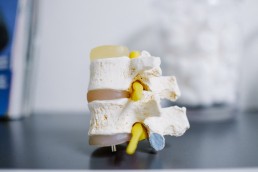LEIMYOSARCOMA-SMOOTH MUSCLE CANCER
Sarcomas are rare types of cancer which develop in the connectives tissues of the body and either form in soft tissue; such as muscle or blood vessels, or in bone or its surrounding tissue.
Leiomyosarcomas are one of the more common types of sarcoma and develop in smooth muscle tissues, which are involuntary muscles that we have no control over. These are found in the walls of muscular organs like the heart and stomach, as well as in the walls of blood vessels throughout the body. This means that leiomyosarcomas can start anywhere in the body and common places are the walls of the womb (uterus), the trunk of the body, and the arms and legs.
The exact causes of leiomyosarcomas are unknown but most people with leiomyosarcoma are over the age of 50.
It is thought that exposure to some chemicals like vinyl chloride, which is used in making plastics or herbicides can increase the risk of developing soft tissue sarcomas. It also seems to develop in areas that have previously been treated by radiotherapy, however usually a decade after exposure.
Symptoms may include:
- a lump or swelling
- abdominal discomfort or bloating
- swelling or pain in any area of the body
- vaginal bleeding or abnormalities in periods.
These symptoms are very vague and therefore sarcomas can be difficult to diagnose until scans are performed.
As sarcomas are rare, they are usually treated at a specialist hospital. This means that you may have to travel some distance to have your treatment.
The treatment for leiomyosarcoma| depends on a number of things, including your general health and the size and position of the tumour in the body. The results of your tests will help your doctor plan the best type of treatment for you. They will then discuss this with you.
The usual treatment is surgery to remove the tumour which is then followed by radiotherapy to reduce the chance of it coming back. Chemotherapy is also used but mainly for recurrence or if the tumour has spread.
Unfortunately about 50% of sarcoma patients will have a recurrence. Some of these will be localized and reoccur in the same site as previously found but many will involve metastasis where secondary tumours will develop in sites quite far away from the original site. The most usual site for metastasis is the lungs although the liver and, more rarely, bones or the lymph system, can be affected.
With single or multiple tumours growing in the lungs it can make breathing difficult and sometimes painful and if surgery is not an option to alleviate this then many patients will need supplemental oxygen to aid with breathing. In many cases chemotherapy can reduce or treat these recurrences but in some the tumours are not responsive or are growing too fast and supplemental oxygen will help improve quality of life for the patient.
As these types of cancer are rarer and still unknown there needs to be more awareness and fund-raising for research into why they occur and how to treat them.
References: www.macmillan.org.uk and www.sarcoma.org.uk
Oxygen can help spinal cord injuries
Depending upon the severity and location of the spinal cord injury will determine the severity of medical problems suffered by the patient, from a slight loss of sensation all the way up to breathing problems and complete paralysis. Many patients commonly suffer breathing problems where the nerves have been damaged that help regulate breathing and many require supplemental oxygen just to be able to breathe. However even in spinal cord patients who suffer difficulty in just walking; low level oxygen treatment may be the answer to helping them to regain their walking ability. Nearly two-thirds of all spinal cord injuries are known as in-complete, in that they haven’t been totally severed and some nerve endings are still intact.
There is a loss of function but it is not completely lost, someone may be able to walk but not in the same way as they used to and may rely on crutches, canes or wheelchairs to get around. Low level (hypoxia) oxygen treatment causes the release of serotonin which is a brain chemical that helps to transmit the messages from one nerve cell to another. It also causes the release of a growth factor that is known to help to repair nerves.
In a study last year spinal cord patients with limited ability were divided into two groups; one group received oxygen therapy and the other a placebo. The hypoxia treatment involved subjects breathing low oxygen levels through a mask for 90 seconds, followed by 60 seconds of normal oxygen levels, and they were required to do this for 40 minutes a day for 5 days. It was shown that the group on low level oxygen therapy walked an average of 3.8 seconds faster, compared with when they breathed only normal oxygen levels. On a test of how far subjects could walk in 6 minutes, those who received the hypoxia treatment increased their endurance by an average of 100 meters - a 250% increase, compared with those who received the placebo. This illustrates oxygen’s versatility of being medically important in treating patients both at high and low levels.
References: www.consumer.healthday.com and www.medicalnewstoday.com
Living with COPD
TOP TIPS FOR LIVING WITH COPD
There are over 3 million people in the UK live with COPD. COPD affects people not just physically but mentally, emotionally and socially too.
If you are affected by COPD, here are some tips to help you manage your condition:
Be active
It's very important to stay as active as possible, not only to keep a healthy weight but regular exercise can help to manage your breathlessness, reduce flare-ups and creates opportunities to meet new people. There are pulmonary rehabilitation classes that your doctor can refer you to so that you can exercise with other patients suffering from similar conditions. Even just walking everyday can help, but there is no reason that patients cant keep on doing the activities they used to do before their diagnosis whether it be swimming, cycling or running.
Talk to others
Having a long-term illness can put a strain on your relationships. Constantly battling with your breathing can lead to depression and constant tiredness and your partner or carer can feel frustrated and anxious watching it happening to you. Talking to each other and being open about how you feel is important, it can help put others at ease. Even if you need to ask to have some alone time. There are also many forums and support groups that you can join so you can talk to other COPD and get advice and tips and make you feel less isolated.
Take things slowly and plan ahead
It's important to take things slowly, pace yourself and plan ahead for each day. From when you wake up you need to think about how best to conserve your energy, still remain active and think about whether there will be any factors during the day that could induce a flare-up such as over-exertion, pollen or heat. Certain times of the day make some activities easier and there are gadgets and handy tips that can help make daily tasks a lot easier to manage. It is important to know how your body might react to different activities or situations so that you can plan and prepare for moments of breathlessness. Planning may sound time-consuming or boring but in the long-run it will make your life easier and even help to improve your condition.
Regular reviews
As COPD is a long term condition and monitoring your condition is very important to ensure you are getting the best help and medication to help ease your condition. You should ensure you regularly see your doctor and you should get regular help and advice from a health care professional (HCP). Your condition can improve or worsen over time and your HCP can provide help, advice, recommend changes to your medications to help support you through out your illness. Occupational Therapists can help adjust your home and lifestyle to best suit your condition and improve your quality of life.
Look after your oxygen
If you have been prescribed oxygen then it is important to understand your equipment and prescription. Make sure you know how to use and maintain your oxygen equipment, ask your oxygen supplier if you are unsure or if you think you need different equipment to make your life easier. Ensure you follow safety guidelines around oxygen as it can be dangerous and follow safety tips around using the equipment at home to avoid trips and falls. Ensure that you have regular appointments with your doctor to ensure your prescription remains correct and let your doctor know if your breathing worsens or if you think you may need oxygen at night as well as during the day. Lots of tips and advice surrounding the use of oxygen and oxygen equipment can be found on various websites including the NHS, British Lung Foundation and Oxygen Worldwide, to name a few.
References: http://blog.blf.org.uk
How to get a better nights sleep
Sleep is fundamental to our health, a good night's sleep helps us to think quickly, focus on tasks, gives us energy, we perform better, it is good for our heart, our moods and helps to maintain a healthy weight.
However when you suffer from a medical condition like COPD it can make sleeping difficult, which is even more important as not enough sleep can weaken the immune system, make you more vulnerable to infections and prevent the body from self-healing. This can result in daytime sleepiness and your health deteriorating, as it can prevent you from getting the exercise you need to help strengthen your heart and lungs.
Oxygen levels are already low in people with COPD and drop even lower at night. Your brain responds by waking you up periodically to catch your breath—preventing you from entering the critical, restorative phases of deep sleep that you need.
Common causes of sleep problems with COPD:
- Sleep position: Many people with COPD find breathing more difficult lying down and try to sleep in a more upright position but sittung up makes it hard to fall asleep and to stay asleep.
- Medications: Some prescribed drugs for COPD can keep you awake and others result in frequent bathroom trips which can disrupt your sleep.
- Mental Health: COPD patients are prone to an increased risk of anxiety and depression which can lead to sleep problems.
- Sleep-related breathing changes: When healthy people go to sleep your breathing slows and becomes less responsive to stimuli, however if you have COPD this can cause sleep disturbances.
- Sleep Apnea: 10-15% of COPD patients also suffer from sleep apnea where your breathing is interrupted when you sleep. Sleep apnea can cause snoring, frequent awakenings and daytime sleepiness.
- Acid reflux: More than half of COPD patients have acid reflux which can result in heartburn, causing you to wake up at night.
Tips for better sleep:
- Adjust COPD medications: Your doctor may be able to adjust your medications so that you will sleep better.
- Add oxygen therapy: Night-time oxygen treatment can sometimes make it easier for you to sleep. Equipment can be obtained via the NHS with a doctor's prescription or through private companies.
- Treat underlying infections: If you have an underlying problem, such as a respiratory infection, that is making it difficult for you to sleep, getting treatment can improve your rest.
- Try sleep medications: Your doctor may prescribe a sleep medication that will help you sleep better.
- Practice airway clearance techniques: Your doctor can teach you airway clearance techniques that may help you sleep better.
- Use CPAP if you have obstructive sleep apnea. Continuous positive airway pressure (CPAP) devices deliver a steady stream of air through a nasal mask you wear overnight.
General tips for anyone trying to sleep:
- Reserve your bed for just sleeping and avoid watching TV, reading, or just lying awake in your bed.
- Get out of bed if you are not able to fall asleep within 20 minutes and do something relaxing until you feel sleepy enough to go to sleep.
- Avoid napping so that you will be sleepy at bedtime.
- Get regular exercise, but not in the two hours before bedtime.
- Make sure your bedroom is quiet, dark, and cool.
- Don't drink caffeine in the five hours before you go to bed.
- Keep a regular sleep schedule, going to bed and waking around the same time each day.
References: www.everydayhealth.com and http://www.healthcommunities.com
How to sleep better during the summer months
Many who suffer with respiratory disorders also find it difficult to sleep at night, often suffering from sleep apnoea and requiring oxygen at night. Extremes of temperatures can affect your sleep and your health.
Sleep apnoea is caused when the upper throat muscles relax too much during sleep, cutting off or restricting the airway. These episodes, which also cause the oxygen level in the blood to drop, last from 10 seconds to a minute or longer. The brain registers the lack of oxygen and the individual wakes up just enough to open the throat and begin breathing again, starting the cycle over. Most of the time, individuals don’t remember these episodes in the morning, but they severely disrupt the restorative effects of sleep.
Being too hot or too cold can worsen the situation, resulting in disrupted sleep, low oxygen levels, worsening health conditions and drowsiness the following day. Many find using oxygen at night helps to maintain oxygen levels, minimises the frequency of waking up and prevents your respiratory problems from worsening, but if you're too hot during the summer months you still need to be able to sleep soundly as sleep provides you with so many rejuvenating and healing properties.
The most important factor is the ambient temperature in your bedroom, this needs to be slightly cool in order to help keep your body's core temperature lower. Otherwise it puts the body clock out of sync and you wont sleep properly. It's better for it to be a bit nippy as you get into bed as your body will generate heat during the night from metabolism and trying to maintain your body's core temperature at the correct level.
If you're lucky enough to have an AC unit then use it, however for the rest of us there are some ways that can help to make sure you get a good night's sleep.
1) Pillows
The head is the hottest part of the body so you want to keep it as cool as possible. Conventional pillows surround your head, trapping in the heat. A smaller, firmer pillow, although less comfy will allow more air circulation.
2) Fans
You can make a cheap version of an AC unit using these three simple household items – an electric fan, a large mixing bowl and some ice cubes. Place the ice cubes in the bowl, in the path of the airflow coming from the fan. The warm air causes the ice to melt, dispersing a cool breeze around the room.
3) Sleep like a Pharaoh
The so-called Egyptian method requires either a bed sheet or a towel large enough to cover your body. Soak the sheet in water, then put it in the washing machine on spin cycle -or just wring it out to stop any dripping. When you go to sleep, cover yourself with the damp sheet. This will keep you cool via latent heat, the same process that sweating uses to cool your body down.
4) Keep the sun out
The sun’s rays are far more powerful in the summer and keeping the blinds down stops the rooms heating up during the day.
5) Change what you eat
Usually when it;s hot you don't feel like eating big meals anyway but remember that the larger the meal, the more metabolic heat you generate as your body breaks down the food. Try switching to salads, fruits and vegetables that the body can metabolise with less effort. If you cook a lot at home, switching to more raw foods will also mean less cooking, which means less heat being generated inside the house.
6) Location
You could try sleeping in a hammock, as being suspended in mid-air means that air flows all around your body, unlike a mattress which absorbs and reflects your body heat. Lower storeys are generally cooler than upper ones as heat rises. Finally, if all else fails, there’s always outdoors.
If you do use oxygen at night ensure there is air flow in the room and maybe use a dehumidifier, as the equipment may be generating heat while you are trying to sleep. Also check with your doctor if you are having trouble sleeping as they may adjust your oxygen flow rate settings if needed.
References: http://sleepjunkies.com and www.sleepapnea.com
HOW THE SUMMER HEAT CAN AFFECT YOU
Whether you're abroad or at home this summer it is recommended that those of us with respiratory-related illnesses should use caution as there is a strong link between rising temperatures and increased hospital admissions.
Older people have more difficulty adjusting to rising outdoor temperatures than younger people because as we age our body finds it harder and is less efficient at thermoregulation. This is the body's ability to maintain your internal temperature within a healthy temperature range. Older people are also more likely to suffer from conditions such as heart failure, obesity, heart disease and obesity which heat can worsen, and take medication such as diuretics, beta blockers and antidepressants which can interfere with the body's ability to cool off and perspire.
In a recent study there was shown a correlation between rising temperatures and the number of emergency admissions for people suffering with COPD and respiratory tract infections in the over 65 population. Even when air quality, pollution, pollen and ozone levels were taken into account, the heat exposure factor was still the most significant and even the following day after heat exposure the risk of hospitalisation was still extremely high.
The study suggested that the poor respiratory effects to heat exposure was likely due to the inhalation of hot air.
Inhaling hot air can exacerbate disorders like COPD as it can cause a bronchospasm which contracts he airways making it harder to breathe and this can happen just a few minutes are exposure. Breathing hot air may also aggravate existing respiratory infections which may also be initiated by pollen or mould.
Poor thermoregulation also plays a part as if you cant cool your body off it will result in hyperthermia which has symptoms such as heat cramps, heat exhaustion and heatstroke. It can cause a rapid heartbeat and increased blood flow to the skin for it to cool off, leaving vital organs deficient in blood flow and therefore oxygen.
The body will work harder as it tries to keep cool and therefore require additional oxygen supplies leading to rapid deep breathing (hyperpnea) and can lead to decreased lung function.
However it does seem that if you grew up in an area that experiences high summer temperatures then your body is used to acclimatising to these temperatures. It can thermoregulate fairly efficiently as your body's ability to do this improves with repeated exposure. People who are not used to long-term heat can have a harder time adjusting and when we experience a heat-wave or go on holiday our bodies have difficulty adjusting and being able to regulate our body temperature and can impact our respiration ability.
The advice is to keep informed of heat, humidity and air quality whether at home or abroad and make sure you are prepared in case your symptoms worsen suddenly. Ensure you have enough medication, water to take it, oxygen equipment and a back-up concentrator and cannula in case of equipment failure. If travelling abroad a global oxygen supplier can arrange for additional equipment to be available for you, as it's better to be safe than sorry.
References: www.healthcommunities.com
Oxygen could also help treat diabetes
It’s not often heard that diabetic sufferers use oxygen therapy, however it is becoming increasingly more recognised as a form of treatment.
 Diabetics are more prone to many other medical diseases and ailments as a result of their condition. They have circulatory problems leading to sores, ulcers and amputation. They also suffer from many organ-related problems, obesity, nerve dysfunction, sleep apnea, eye degeneration and loss of eyesight among many others.
Diabetics are more prone to many other medical diseases and ailments as a result of their condition. They have circulatory problems leading to sores, ulcers and amputation. They also suffer from many organ-related problems, obesity, nerve dysfunction, sleep apnea, eye degeneration and loss of eyesight among many others.
Diabetics usually have circulatory problems where the blood flow to bodily tissues is diminished and their arteries tend to thicken due to not being able to digest fats such as cholesterol very well because of their high blood glucose levels. This is compounded by the fact that less blood is able to reach the tissue and therefore unable to deliver oxygen to them. Cells become oxygen depleted and can die off leading to gangrene and being unable to fight off infections.
Diabetics have to either inject insulin or radically alter their diet and lifestyle but many find this difficult to do or maintain and the disease can speed up in its progression. This can lead to other medical issues and the need for treatments and medications, exercise and close monitoring by your GP. The additional use of oxygen therapy can help a great deal to prevent serious complications from Diabetes.
Using oxygen therapy will help over time, since additional oxygen will be distributed throughout the blood vessels of the body, and reach your tissues and extremities, where people with diabetes often have the most problems. If the oxygen levels can be kept high enough in the body then the risk is lowered that extremities will suffer tissue damage and organs become damaged and reduce the possibilities of further medical issues and complications. It has been shown to reduce fluid build-up in the eye and to prevent and treat eye sight problems such as glaucoma, which is largely attributed to diabetes. Many suffer from sleep apnea, partly to do with the tendency to put on weight when you are a diabetic. Oxygen therapy helps to relieve your symptoms at night and make you feel more energised and healthier during the day. There are links between oxygen therapy and a reduction in heart tissue damage from strokes and improved wound healing, such as with ulcers and a general improvement in circulation and a reduction in circulatory medical conditions.
The realisation that diabetics require additional oxygen in their bodies to counteract the poor circulation and the inability for oxygen to pass through thickened vessel walls. And that this in itself can help to prevent and treat many medical conditions associated with Diabetes has led to patients being prescribed oxygen therapy and studies have shown that supplemental oxygen does work and GP’s are starting to prescribe it more regularly, especially as the benefits of other oxygen therapy users such as COPD sufferers are so apparent.
References: http://www.oxygenconcentratorstore.com and http://www.oxygenhealingtherapies.com
Could Oxygen be used to burst cancer's bubble?
The link between oxygen and tumour cells has been established, not only in that low oxygen levels can result in cancerous cells but that also by increasing oxygen these tumour cells can be destroyed. Finding a way to do this has been difficult as blood vessels supplies to tumour sites become reduced and so getting oxygen to the site is proving difficult.
Not only are tumour cells able to survive in low oxygen environments but these oxygen-starved cells are more difficult to kill with radiation treatment than normal healthy tissue. Scientists wanted to develop a way in which oxygen could be infused into the tumour, not only to create a more oxygen rich environment to help slow down growth but also so that they can be nuked by treatment more effectively.
One such idea has been to inject tiny oxygen-filled bubbles into a patient’s bloodstream. Microbubbles are miniature gas bubbles, containing oxygen or air, which can be suspended in a liquid such as blood. Due to their size, they can pass through even the smallest of blood vessels, and are commonly used together with medical ultrasound imaging. Microbubbles reflect ultrasound better than blood or soft tissues, which allow them to be used for highlighting blood in ultrasound images.
These microbubbles would travel to the tumour site via the bloodstream, and as the tumour’s blood vessel walls are leakier due to the effects of the tumour, they would gain access to the tumour more easily. These bubbles would then be burst to release oxygen within the tumour.
The ultrasound community already use a similar idea of using gas-filled microbubbles to improve the contrast of images. High-intensity localised ultrasound could be used to view and then rupture these bubbles at the specific site that you want.
In a recent experiment with mice it was shown that the ones treated with oxygen-containing microbubbles released their oxygen and resulted in a detectable oxygen level increase of 30 mmHg at the tumour site. Even a 10-15 mmHg increase would make the tumours twice as sensitive to radiation. Testing is now going ahead to prove whether the radiation does indeed become more effective in killing the tumour cells.
If this idea becomes a reality then cancer sufferers will require less chemotherapy and radiation therapy and experience less side effects as well as having an increased chance of destroying the tumour.
In the meantime we only have conventional methods of increasing oxygen at our disposal, such as oxygen therapy which can increase oxygen levels within the bloodstream, although only a small amount can pass through into the tumour site. Prevention is also being looked into, as low-oxygen levels are a main cause of cancerous cells there are thoughts about putting high risk patients onto low level oxygen therapy regimes as a preventative measure to try to reduce the risk of tumour sites developing.
References: http://www.the-scientist.com and http://thefutureofthings.com
THE IMPORTANCE OF HOME VISITS FOR OXYGEN USERS
Home visits are a bit like Marmite; you either love them or hate them. Patients who are on oxygen require monitoring to see if their oxygen requirement alters over time and this can be done either via home visits or by going to see your GP or consultant at the hospital. Patients have differing opinions over which they feel is more suitable; some feel uncomfortable at the thought of medical personnel invading their personal space at home and prefer the professional and clinical setting of a hospital and some feel that there is little medical benefit to them being seen at home. Whereas others prefer to have to not travel back and forth in their condition and feel more at ease talking to someone in the comfort of their own home. They also feel more able to discuss the smaller things and ask questions during their own home visits rather than at an apparent rushed GP or hospital appointment.

Studies have been carried out to get feedback from patients as to problems they encounter and also to see if there are medical benefits of one method over another.
One such study asked patients about their experiences of using oxygen at home. There was feedback regarding trailing tubing, allergic reactions/irritations to tubing, preferred use of nasal cannulae over masks, continuity problems with supply, portable equipment not being of a portable size, preference of concentrators over cylinders, reduction in infections and less reliance on other medications. There were many that said that they struggled with getting to grips with oxygen use for varying reasons and life was difficult for them until their home visit resolved these for them. The home visit provided them with an opportunity to ask questions and show their home visitor what their issues were. In most cases their questions could be answered, tips/advice given, shown practically how to use their equipment more effectively, educate them on oxygen use and feedback to the hospital or oxygen supply company to resolve issues and monitor the situation to ensure that things were done. Many did not realise that they had options and could contact their supplier or use a private supplier if they wished in order to obtain better equipment that would suit their medical condition or way of life better. There are many studies that show that home visits aid in reducing mortality and readmission into hospital.
A study has been carried out by an NHS trust to ascertain whether home visits were useful and it was realised that home visits allowed for problems to be identified and interventions made to improve the way oxygen is used at home generally, and not just on a case-by-case basis. The most common interventions related to the need of more education, smoking cessation, concentrator maintenance, use of a humidifier and adjustments to tubing. It was found that they were especially important for those who lacked progress of their condition, which in many cases was due to a lack of education of how to use it properly or difficulties in using it, which resulted in reduced use. These issues can be quickly dealt with by home visits and monitoring of patient progress is also easier. It is also a mode for early detection of potential health problems or prevention against flare-ups or emergency situations, which may have been caused by a lack of understanding of their condition or their equipment.
It appears from the studies that home visits are very beneficial to the hospital service and to the patient. It is also more cost-effective to provide this service than to run it from the hospital and not incur the costs of more hospital admissions. Patient progress is monitored, patient's concerns and problems are discovered and resolved which results in a better prognosis for the patient and a reduction of cost for the hospital. Some patients will still need to see their GP or consultant depending on their condition and regular contact should still be maintained but if these can be reduced to a minimum because of home visits then it is extremely beneficial for the patient's general well-being.
References: http://www.gov.scot and http://www.ncbi.nlm.nih.gov















